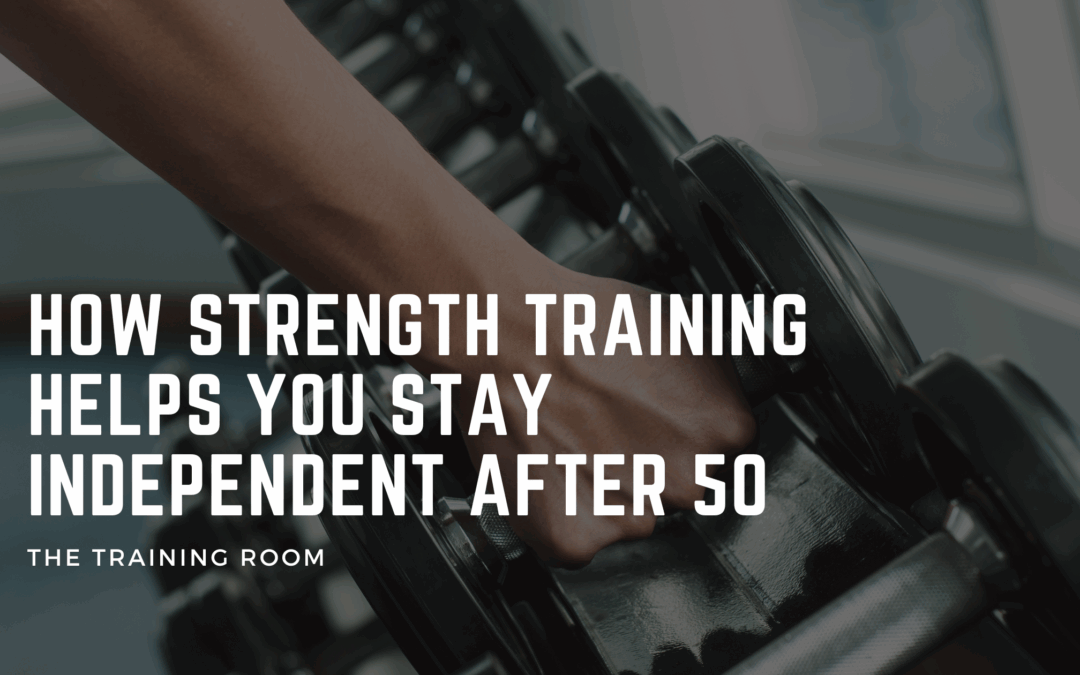Why Muscle Matters After 50
After age 30, adults start to lose muscle mass at a rate of 3–8% per decade. This process, known as sarcopenia, accelerates after age 60. While some loss is a normal part of aging, the good news is this: it’s not inevitable, and it’s reversible through strength training.
Muscle is more than a cosmetic feature. It plays a critical role in:
- Joint support and mobility
- Blood sugar regulation
- Bone density maintenance
- Balance and fall prevention
- Injury recovery
- Independence with daily tasks (carrying groceries, climbing stairs, getting up off the floor)
In short: strong muscles are your best defense against becoming frail or dependent later in life.
What Happens When You Don’t Strength Train?
Without consistent strength training, most people over 50 experience:
- Reduced muscle mass and slower metabolism
- Increased joint stress and risk of chronic pain
- Greater risk of falls and fractures
- Poor posture and reduced balance
- Loss of ability to perform daily activities without assistance
This decline often starts subtly — maybe stairs get harder, or your balance feels off when you’re getting dressed — but it can quickly compound into injury, hospitalization, or long-term care needs.

How Strength Training Preserves Independence
1. Preserves and Rebuilds Muscle Mass
Resistance training (lifting weights, using resistance bands, or bodyweight exercises) is the most effective strategy to stimulate muscle growth — even in older adults. Research shows that even people in their 70s and 80s can build muscle when appropriately challenged.
This is crucial because muscle strength is directly linked to functional independence. If you want to continue living life on your terms — gardening, traveling, picking up your grandkids — your muscle mass is your ticket.
2. Improves Balance and Reduces Fall Risk
Falls are the leading cause of injury in adults over 65. Strength training improves neuromuscular control, postural stability, and joint strength, which dramatically lowers fall risk.
By strengthening the legs, hips, core, and stabilizing muscles, you build the foundation for safe movement — whether you’re walking on uneven ground or catching yourself when you trip.
3. Supports Joint Health and Reduces Pain
Many adults worry that strength training will hurt their joints, but the truth is the opposite. Properly prescribed resistance training:
- Increases joint stability
- Improves cartilage nutrition through movement
- Reduces pain from conditions like arthritis and low back pain
- Helps maintain proper alignment and posture
In fact, strength training is now part of best-practice guidelines for managing osteoarthritis and preventing disability from chronic joint pain.
4. Improves Confidence and Mental Health
There’s a psychological shift that happens when people feel physically strong. Studies show that resistance training improves mood, reduces anxiety, and boosts self-confidence — all key ingredients for staying socially engaged and active in your community.
When you feel strong, you act strong — and that confidence makes it more likely you’ll stay independent longer.
How to Start Strength Training After 50
The good news is: you don’t need to be a bodybuilder or join a CrossFit gym to get results. Safe and effective strength training can be done at home, in a clinic, or in small-group training sessions tailored to your age and goals.
A well-designed program should include:
- Full-body resistance training 2–3 times per week
- Exercises for major muscle groups, especially the legs, back, and core
- Progressive overload, meaning your program gradually increases in challenge
- Focus on form and control, not just heavy weights
Working with a professional — like a chiropractor, personal trainer, or rehab specialist — ensures your program is safe, effective, and aligned with your medical history and goals.
Real Patient Success Story
At our clinic, we recently worked with a 67-year-old patient who came in for chronic knee pain. She was hesitant to start strength training, afraid it would worsen her condition. After a thorough movement assessment and a gradual introduction to resistance training, not only did her knee pain improve — she now walks two miles daily, plays with her grandkids, and feels more confident in her balance and strength than she has in years.
It’s never too late to start.
The Bottom Line
Staying independent after 50 isn’t about luck — it’s about proactive, intentional effort. Strength training is one of the single most powerful tools you have to maintain your health, mobility, and freedom.
Whether you’re 52 or 82, it’s not too late to build strength, protect your joints, and invest in your long-term independence.
Want to Stay Strong and Independent?
At The Training Room, we specialize in helping adults 50+ build strength, improve mobility, and stay out of the doctor’s office.
Our combination of chiropractic care, personalized fitness programs, and movement-based rehab ensures you get the results you’re looking for — safely and efficiently.
👉 Click here to schedule your discovery call and take the first step toward a stronger, more confident you.


Recent Comments